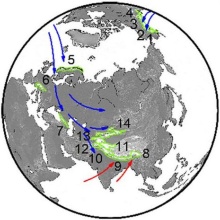High mountain glaciers (HMGs), called the water towers of the world, are vulnerable to the effects of climate change and thus are rapidly shrinking. Monitoring and evaluating large-scale glacier and snow (GS) mass changes are critical for humans and ecosystems. Although modern gravity satellites monitor GS on a global scale, the contemporary Gravity Recovery and Climate Experiment (GRACE) and GRACE Follow−On (GRACE−FO) missions are only able to do so at coarse spatial resolutions and are restricted by their limited observation periods. Moreover, because of the complex mechanism behind a glacier's mass balance, existing reconstruction methods for GRACE-like mass anomalies, including machine learning approaches and statistical models, cannot be applied to HMGs. Here, we propose a precipitation and temperature data-driven statistical model combining hydrology and GS processes to reconstruct GRACE-like mass anomalies of HMGs, from which the hydrological and GS signals can be further separated. The prediction and reconstruction performance of this method was consistent with the GRACE/GRACE−FO observations (the median correlation coefficient/Nash-Sutcliffe efficiency: ~0.92/0.85). Additionally, the separated GS signals agreed with the independent external data used for comparison. Compared with machine learning methods, this method better reconstructed the long-term trend of GRACE-like mass anomalies. Our study provides an acceptable method for expanding mass anomaly time series on HMGs, thereby assisting in the sustainable management and protection of water resources in their downstream areas.
Link to article in 'Remote Sensing of Environment' - Volume 280


